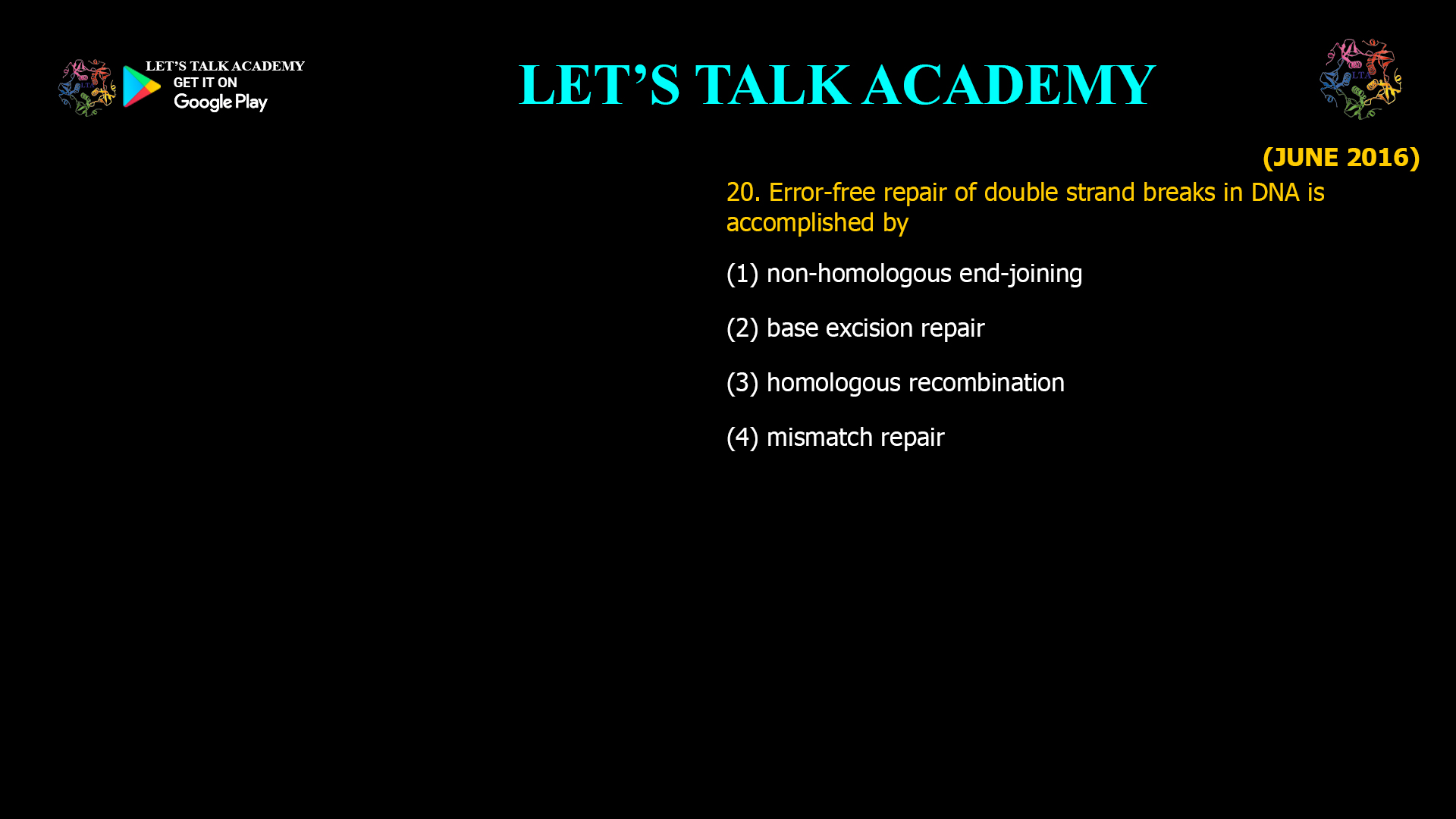- Error-free repair of double strand breaks in DNA is accomplished by
(1) non-homologous end-joining
(2) base excision repair
(3) homologous recombination
(4) mismatch repairError-Free Repair of DNA Double-Strand Breaks: Homologous Recombination vs. Other Repair Mechanisms
DNA double-strand breaks (DSBs) are among the most severe forms of DNA damage, threatening genomic stability and cell survival. Cells have evolved multiple pathways to repair DSBs, but not all are equally accurate. Understanding which mechanism accomplishes error-free repair is crucial for insights into genome maintenance, cancer biology, and therapeutic strategies.
Major DSB Repair Pathways
-
Non-Homologous End Joining (NHEJ)
-
Joins broken DNA ends directly without requiring sequence homology.
-
Active throughout the cell cycle, especially in G1 phase.
-
Fast and efficient but error-prone, often causing small insertions or deletions at the break site.
-
-
Homologous Recombination (HR)
-
Uses a homologous DNA sequence (usually the sister chromatid) as a template for repair.
-
Occurs mainly in S and G2 phases when sister chromatids are available.
-
Considered error-free because it restores the original DNA sequence precisely.
-
-
Base Excision Repair (BER)
-
Repairs small base lesions or single-strand breaks, not double-strand breaks.
-
-
Mismatch Repair (MMR)
-
Corrects base mismatches and insertion/deletion loops formed during replication, not DSBs.
-
Why Homologous Recombination Is Error-Free
-
HR initiates with 5′ to 3′ end resection at the break site, producing 3′ single-stranded DNA tails.
-
The Rad51 protein forms nucleoprotein filaments on these tails, facilitating strand invasion into the homologous duplex DNA.
-
DNA synthesis uses the intact homologous strand as a template, ensuring accurate repair.
-
HR resolves the junctions to restore the original DNA sequence without loss or mutation.
Limitations of Non-Homologous End Joining
-
NHEJ ligates DNA ends regardless of sequence homology.
-
It can lead to nucleotide loss or insertion at the junction, causing mutations.
-
Although predominant in many cells due to its speed and cell cycle independence, it is not error-free.
Supporting Evidence from Research
-
Studies show that HR-deficient cells exhibit increased genomic instability and sensitivity to DNA damaging agents.
-
HR proteins like BRCA1, BRCA2, and RAD51 are crucial for maintaining genome integrity; their mutations are linked to cancer predisposition.
-
NHEJ-deficient cells rely more on HR but may have slower repair kinetics.
Summary Table
Repair Mechanism Error-Free? Requires Homology? Cell Cycle Phase Active Role in DSB Repair Homologous Recombination Yes Yes S/G2 Precise DSB repair Non-Homologous End Joining No No All phases Fast but error-prone repair Base Excision Repair No N/A N/A Repairs small base damage Mismatch Repair No N/A N/A Repairs replication errors
Correct Answer
(3) Homologous recombination
Related Keywords for SEO Optimization
-
DNA double-strand break repair
-
Homologous recombination vs non-homologous end joining
-
Error-free DNA repair
-
RAD51 and BRCA proteins
-
DNA repair pathways
-
Genome stability and DNA repair
-
DNA damage response
-
Cell cycle and DNA repair
-
DNA repair mechanisms in cancer
-
DNA strand invasion and repair synthesis
Conclusion
Among the major DNA double-strand break repair mechanisms, homologous recombination (HR) uniquely accomplishes error-free repair by using a homologous DNA template to restore the original sequence accurately. Non-homologous end joining (NHEJ), while efficient and active throughout the cell cycle, is prone to errors. Base excision repair and mismatch repair do not handle double-strand breaks. Therefore, the correct answer is:
(3) Homologous recombination
-




16 Comments
Deepika Sheoran
November 6, 2025Homologous recombination
Komal Sharma
November 7, 2025Among the major DNA double-strand break repair mechanisms, homologous recombination (HR) uniquely accomplishes error-free repair by using a homologous DNA template
Roopal Sharma
November 7, 2025Homologus recombination
Divya rani
November 7, 2025Homologous recombination is a error free repair of ds breaks in DNA we use sister chromatid as a template.
Sonal Nagar
November 7, 2025Homologous recombination
Rishita
November 8, 2025Homologous recombination
Kirti Agarwal
November 8, 2025Homologous recombination
Mohd juber Ali
November 8, 2025HR is error free use to repair dsdna break
Dipti Sharma
November 8, 2025Homologous recombination.
Neelam Sharma
November 8, 2025Homologous recombination
Anisha Beniwal
November 9, 2025Homologous recombination
priti khandal
November 9, 2025homologous recombination
Heena Mahlawat
November 9, 2025Homologous recombination
Neeraj Sharma
November 13, 2025Homologous recombination
Bhawna Choudhary
November 14, 2025Homologous recombination
Kajal
November 23, 2025HR